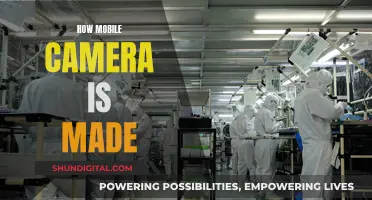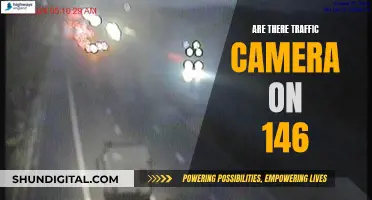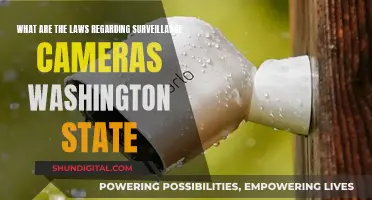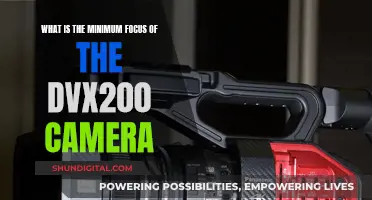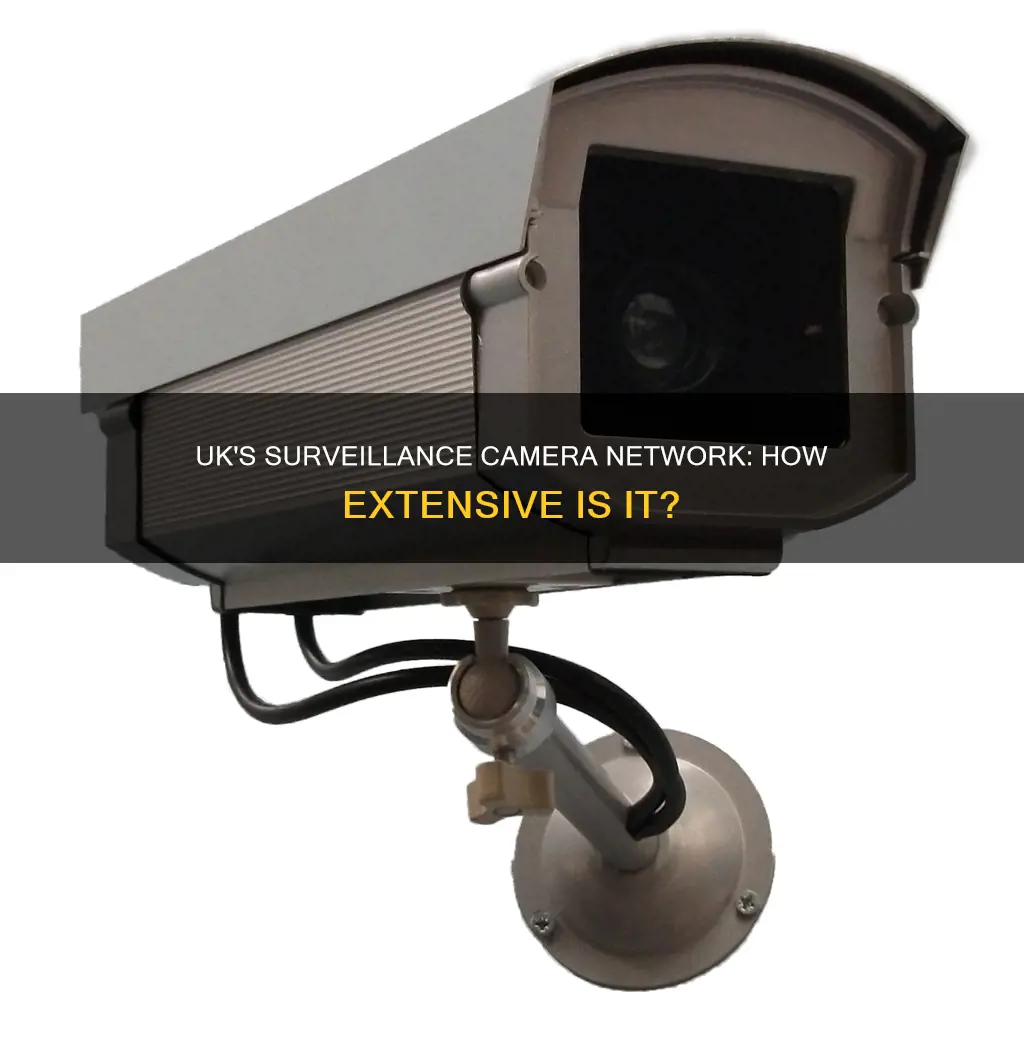
The UK is one of the most surveilled nations in the world, with an estimated 4 to 6 million CCTV cameras across the country. This includes 750,000 cameras in sensitive locations such as schools, hospitals, and care homes. With a population of over 60 million people, this means there is approximately one camera for every 11 people in the UK. The high number of CCTV cameras has sparked a debate about the balance between public safety and privacy, with some critics arguing that the UK is becoming a surveillance state.
| Characteristics | Values |
|---|---|
| Total number of surveillance cameras | 4-6 million |
| Number of cameras per person | 1 for every 11-14 people |
| Number of cameras in "sensitive locations" | 750,000 |
| Number of cameras in public sector schools | 291,000-373,000 |
| Number of cameras in independent schools | 30,000-50,000 |
| Number of cameras in surgeries and health centres | 80,000-159,000 |
| Number of cameras in restaurants | 53,000-159,000 |
| Cost of surveillance | £2.2 billion per year |
What You'll Learn

There are between 4 and 6 million CCTV cameras in the UK
The UK has one of the most comprehensive CCTV networks globally, with an estimated 4 to 6 million surveillance cameras across the country. This equates to approximately one camera for every 11 people, giving Britain the highest number of CCTV cameras per person.
The British Security Industry Association (BSIA) report, titled 'The Picture Is Not Clear', provides a detailed breakdown of the number of cameras in various sectors. The BSIA's complex methodology involved estimating the range of cameras in over 200 sectors, from schools to sewage works. Their calculations included all CCTV cameras, regardless of whether they faced the public or not, providing a comprehensive understanding of the UK's CCTV landscape.
The BSIA report offers a more extensive analysis than previous studies, which estimated lower figures ranging from 1.5 to 4.2 million cameras. The BSIA's lower estimate is 4 million cameras, with a medium estimate of 4.9 million, and a high estimate of nearly 6 million. The middle range of 5 million cameras is considered the most likely scenario, highlighting the extensive reach of CCTV in the UK.
The prevalence of CCTV cameras in the UK has sparked debates about the "surveillance state" and concerns about privacy. While some argue that CCTV schemes are invaluable for crime detection and evidence gathering, others criticise the lack of transparency and the potential infringement on civil liberties. The UK's extensive CCTV network and the ongoing discussions about its benefits and drawbacks showcase the complex nature of balancing security and privacy in a modern society.
The UK's CCTV network is just one part of a broader global trend towards increased surveillance. By the end of 2021, it was estimated that there were over 1 billion surveillance cameras installed worldwide, with China leading the way in terms of camera density. The UK's extensive CCTV network places it among the most surveilled nations, raising questions about the impact of such widespread monitoring on privacy and freedom.
Trail Camera Power: Battery Options for Stealth Cameras
You may want to see also

That's one camera for every 11 people
The UK has long been known for its extensive use of CCTV cameras, and this reputation is not without merit. In 2013, a report by the British Security Industry Association (BSIA) estimated that there were between 4 and 5.9 million CCTV cameras across the country. This range of figures translates to approximately one camera for every 11 to 14 people in the UK. The BSIA's report, titled "The Picture Is Not Clear", is particularly notable as it includes all CCTV surveillance cameras, regardless of whether they are publicly or privately owned and operated.
The BSIA's estimate of 4 to 5.9 million CCTV cameras is significantly higher than previous estimates, which ranged from 1.5 to 4.2 million. This discrepancy can be attributed to the fact that most previous studies only considered publicly owned and operated cameras. However, it is important to note that private businesses and homeowners own and operate the majority of CCTV cameras in the UK. The proliferation of low-cost home CCTV systems and smart doorbells, such as Amazon Ring, has further contributed to the increase in the number of private cameras.
The BSIA's report also highlights the complexity of determining accurate figures for the number of CCTV cameras in the UK. They employed a sophisticated methodology to estimate high, low, and medium figures for each sector, which included schools, hospitals, care homes, and even sewage works. By summing up these estimates, they arrived at their final range of 4 to 5.9 million cameras. While the BSIA acknowledges that no single reliable source of data exists, they maintain that their report is the most comprehensive to date.
The high number of CCTV cameras in the UK has sparked concerns about the growth of a "surveillance state". Privacy campaigners, such as Nick Pickles of Big Brother Watch, have criticized the increasing prevalence of CCTV cameras as an invasion of privacy and a threat to democratic values. They argue that the UK's extensive surveillance culture is not in line with the expectations of a healthy democratic society.
Despite the concerns raised by privacy advocates, supporters of CCTV cameras highlight their effectiveness in crime detection and evidence gathering for law enforcement. For example, in 2009, 95% of Scotland Yard murder cases utilized CCTV footage as evidence. Additionally, studies have shown that CCTV cameras can lead to a decrease in certain types of crimes, such as drug-related crimes, vehicle crimes, and property crimes. However, it is worth noting that violent crimes do not seem to be affected by the presence of cameras.
Mastering the Samsung S7 Camera Focus: Tips and Tricks
You may want to see also

The government only has access to a tiny proportion of these
The UK is one of the most surveilled nations in the world, with an estimated 5.9 million CCTV cameras across the country. This includes 750,000 cameras in "sensitive locations" such as schools, hospitals, and care homes. With a population of approximately 67 million, this means there is roughly one CCTV camera for every 11 people in the UK.
While the number of CCTV cameras in the UK may be high, it is important to note that the government only has access to a tiny proportion of these. According to a report by the British Security Industry Association (BSIA), the proportion of cameras controlled by local government is around 1 in 70. This means that the vast majority of CCTV cameras in the UK are privately owned and not accessible to the government or law enforcement agencies.
The BSIA report, titled "The Picture Is Not Clear", estimates the number of CCTV cameras in over 200 sectors of the economy, including both public and private sectors. The report uses a complex method to determine high, low, and medium figures for each sector, which are then added together to produce estimates. The low estimate is 4 million cameras, the medium estimate is 4.9 million, and the high estimate is nearly 6 million.
The BSIA claims that their report represents the most comprehensive study on the number of CCTV cameras used in the UK. However, they also acknowledge that there is no single reliable source of data, and the exact figure may never be truly known. The report highlights that private companies fund most of the nation's CCTV cameras because they offer a better return on investment. These private companies also provide the majority of footage used by the police for crime detection and evidence.
Pauline Norstrom, vice chair of the BSIA's CCTV section, emphasized that "day to day, these cameras are not available to the Government and law enforcement agencies. They are busy working to protect their owner’s premises." She further stated that it is only in the case of a major crime that the police may request footage from private businesses, and without this cooperation, the police would only have access to a tiny fraction of the available CCTV cameras.
Speeding Camera Tickets in South Dakota: Do You Pay?
You may want to see also

The police use CCTV footage in 95% of murder cases
The UK has between 4 and 6 million CCTV cameras, according to a 2013 report by the British Security Industry Association (BSIA). This includes cameras in schools, hospitals, and care homes. With such a huge number of cameras, it's no surprise that CCTV footage is commonly used by the police to solve crimes. In fact, in 2009, 95% of Scotland Yard murder cases used CCTV footage as evidence.
CCTV cameras are often used to monitor public areas like car parks, town centres, and housing estates. The footage is typically monitored at a local station, and if any criminal activity is noticed, operators can call for a direct police response. In addition to government-owned cameras, many private businesses and individuals also have their own CCTV systems to monitor their properties.
The effectiveness of CCTV in crime detection and evidence gathering is well-established. For example, in the aftermath of the 7/7 London bombings, counter-terrorism police identified the attackers within four days using CCTV footage. They worked backward from the attack locations, eventually isolating the suspects on camera at Kings Cross.
CCTV was also instrumental in apprehending many of those involved in the 2011 London riots. Police reviewed over 200,000 hours of footage, which directly led to around 5,000 arrests. In addition to solving crimes, CCTV has been shown to help prevent them. The presence of CCTV cameras can act as a deterrent, and in car parks that use CCTV surveillance, the number of crime incidents has been reduced by 51%.
While CCTV footage can be incredibly useful for solving crimes, it's important to note that it is not always dependable. Issues such as poor-quality images, inaccessible or lost footage, and the lack of skilled personnel to interpret footage can hinder investigations. Additionally, the large volume of CCTV data can be challenging to manage and may result in important footage being overlooked or not disclosed to the defence, potentially leading to miscarriages of justice.
The First Camera Phone: A Revolutionary Invention
You may want to see also

London is one of the most surveilled cities in the world
London, with its population of over 9.6 million people, has 127,423 cameras. This means that there are 13.21 cameras for every 1,000 people, or 209.94 cameras per square mile. London is the eighth most surveilled city outside of China, based on the number of cameras per 1,000 people, and the seventh most surveilled city outside of China when ranked by the number of cameras per square mile.
The high number of CCTV cameras in the UK has sparked a debate about the extent of surveillance in the country. Privacy campaigners have criticised the growth of the "surveillance state", arguing that the proliferation of cameras and the use of emerging technologies, such as Automated Facial Recognition, are intrusive and raise concerns about civil liberties.
On the other hand, supporters of CCTV surveillance argue that it is an invaluable tool for crime detection and evidence gathering. For example, in 2009, 95% of Scotland Yard murder cases used CCTV footage as evidence. The effectiveness of CCTV in solving crimes has led to its increased adoption, with private companies funding most of the nation's CCTV systems as they offer a good return on investment.
The UK government has also recognised the need to modernise its CCTV technology, establishing initiatives like the Video Analytics for Law Enforcement (VALE) to find new technologies that can improve the archaic tools currently in use.
Understanding Long Shutter Mode in Photography
You may want to see also
Frequently asked questions
There are an estimated 4 to 6 million CCTV cameras in the UK.
Private businesses own most of the surveillance cameras in the UK, not the government.
Surveillance cameras are used for various purposes, including crime prevention, traffic monitoring, and observing industrial operations.
The effectiveness of surveillance cameras in crime prevention is debated. While they can provide valuable evidence for criminal investigations, the volume of footage can be overwhelming and time-consuming to analyse.
Yes, privacy campaigners have criticised the growth of the "surveillance state" and the potential infringement on people's privacy and civil liberties. There are also concerns about the lack of meaningful public engagement and debate regarding the use of surveillance technology.



